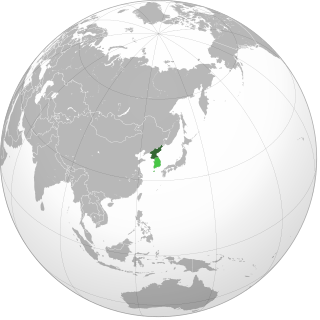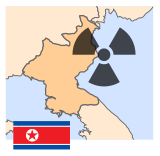
North Korea has a military nuclear weapons program and, as of early 2020, is estimated to have an arsenal of approximately 30 to 40 nuclear weapons and sufficient production of fissile material for six to seven nuclear weapons per year. North Korea has also stockpiled a significant quantity of chemical and biological weapons. In 2003, North Korea withdrew from the Treaty on the Non-Proliferation of Nuclear Weapons (NPT). Since 2006, the country has conducted six nuclear tests at increasing levels of expertise, prompting the imposition of sanctions.

Operation Ivy was the eighth series of American nuclear tests, coming after Tumbler-Snapper and before Upshot–Knothole. The two explosions were staged in late 1952 at Enewetak Atoll in the Pacific Proving Ground in the Marshall Islands.

Project Plowshare was the overall United States program for the development of techniques to use nuclear explosives for peaceful construction purposes. The program was organized in June 1957 as part of the worldwide Atoms for Peace efforts. As part of the program, 35 nuclear warheads were detonated in 27 separate tests. A similar program was carried out in the Soviet Union under the name Nuclear Explosions for the National Economy.

A mushroom cloud is a distinctive mushroom-shaped flammagenitus cloud of debris, smoke, and usually condensed water vapor resulting from a large explosion. The effect is most commonly associated with a nuclear explosion, but any sufficiently energetic detonation or deflagration will produce the same effect. They can be caused by powerful conventional weapons, like thermobaric weapons such as the ATBIP and GBU-43/B MOAB. Some volcanic eruptions and impact events can produce natural mushroom clouds.

Nuclear weapons tests are experiments carried out to determine the performance, yield, and effects of nuclear weapons. Testing nuclear weapons offers practical information about how the weapons function, how detonations are affected by different conditions, and how personnel, structures, and equipment are affected when subjected to nuclear explosions. However, nuclear testing has often been used as an indicator of scientific and military strength. Many tests have been overtly political in their intention; most nuclear weapons states publicly declared their nuclear status through a nuclear test.

Ryanggang Province is a province in North Korea. The province is bordered by China (Jilin) to the north, North Hamgyong to the east, South Hamgyong to the south, and Chagang to the west. Ryanggang was formed in 1954, when it was separated from South Hamgyŏng. The provincial capital is Hyesan. In South Korean usage, "Ryanggang" is spelled and pronounced as "Yanggang" Korean: 양강도; RR: Yanggang-do, Korean pronunciation:[jaŋ.ɡaŋ.do]).
The Ryongchŏn disaster was a train disaster that occurred on 22 April 2004 in the town of Ryongchŏn, North Korea, near the border with the People's Republic of China. At least 54 people were killed, including some Syrian scientists.

Since their public debut in August 1945, nuclear weapons and their potential effects have been a recurring motif in popular culture, to the extent that the decades of the Cold War are often referred to as the "atomic age".

A nuclear explosion is an explosion that occurs as a result of the rapid release of energy from a high-speed nuclear reaction. The driving reaction may be nuclear fission or nuclear fusion or a multi-stage cascading combination of the two, though to date all fusion-based weapons have used a fission device to initiate fusion, and a pure fusion weapon remains a hypothetical device. Nuclear explosions are used in nuclear weapons and nuclear testing.
Divine Strake was the official designation for a large-yield, non-nuclear, high-explosive test that was planned for the Nevada National Security Site, formerly the Nevada Test Site. Following its announcement, the test generated great controversy, centering on two issues: its potential value in developing a nuclear "bunker buster" warhead, and the possibility that the mushroom cloud generated by the explosion could carry large amounts of radioactive dust deposited at the Test Site over years of nuclear testing.

Behind Enemy Lines II: Axis of Evil is a 2006 American action war film and the sequel to 2001's Behind Enemy Lines. The film was written and directed by James Dodson, starring Nicholas Gonzalez, Matt Bushell, Keith David, Denis Arndt, Ben Cross, Bruce McGill and Peter Coyote. The film was released direct-to-video on October 17, 2006.

The 2006 North Korean nuclear test was the detonation of a nuclear device conducted by North Korea on October 9, 2006.

This chronology of the North Korean nuclear program has its roots in the 1950s and begins in earnest in 1989 with the end of the Cold War and the collapse of the Soviet Union, the main economic ally of North Korea. The chronology mainly addresses the conflict between the United States and North Korea, while including the influences of the other members of the six-party talks: China, Russia, South Korea, and Japan.
The July 2007 Syrian arms depot explosion was a blast in July 2007 at a highly secretive Syrian missile base. The Syrian government said the explosion was the result of an accidental detonation of an ammunition dump, but later reports suggested it was the result of a Syrian chemical weapons experiment.

The 2009 North Korean nuclear test was the underground detonation of a nuclear device conducted on Monday, 25 May 2009 by the Democratic People's Republic of Korea. This was its second nuclear test, the first test having taken place in October 2006. Following the nuclear test, Pyongyang also conducted several missile tests. A scientific paper later estimated the yield as 2.35 kilotons.

A transient condensation cloud, also called a Wilson cloud, is observable surrounding large explosions in humid air.

On 12 February 2013, North Korean state media announced it had conducted an underground nuclear test, its third in seven years. A tremor that exhibited a nuclear bomb signature with an initial magnitude 4.9 was detected by the China Earthquake Networks Center, Preparatory Commission for the Comprehensive Nuclear-Test-Ban Treaty Organization and the United States Geological Survey. In response, Japan summoned an emergency United Nations meeting for 12 February and South Korea raised its military alert status. It is not known whether the explosion was nuclear, or a conventional explosion designed to mimic a nuclear blast; as of two days after the blast, Chinese, Japanese, and South Korean investigators had failed to detect any radiation.
North Korea conducted its fourth nuclear detonation on 6 January 2016 at 10:00:01 UTC+08:30. At the Punggye-ri Nuclear Test Site, approximately 50 kilometres northwest of Kilju City in Kilju County, an underground nuclear test was carried out. The United States Geological Survey reported a 5.1 magnitude earthquake from the location; the China Earthquake Networks Center reported the magnitude as 4.9.

The government of North Korea conducted a nuclear detonation on 9 September 2016, the fifth since 2006, at the Punggye-ri Nuclear Test Site, approximately 50 kilometres northwest of Kilju City in Kilju County.













